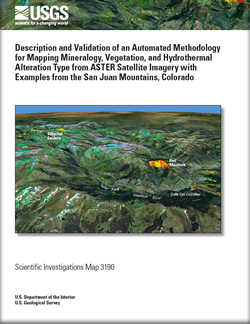 Abstract Abstract
The efficacy of airborne spectroscopic, or “hyperspectral,” remote sensing for geoenvironmental watershed evaluations and deposit-scale mapping of exposed mineral deposits has been demonstrated. However, the acquisition, processing, and analysis of such airborne data at regional and national scales can be time and cost prohibitive. The Advanced Spaceborne Thermal Emission and Reflection Radiometer (ASTER) sensor carried by the NASA Earth Observing System Terra satellite was designed for mineral mapping and the acquired data can be efficiently used to generate uniform mineral maps over very large areas.
Multispectral remote sensing data acquired by the ASTER sensor were analyzed to identify and map minerals, mineral groups, hydrothermal alteration types, and vegetation groups in the western San Juan Mountains, Colorado, including the Silverton and Lake City calderas. This mapping was performed in support of multidisciplinary studies involving the predictive modeling of surface water geochemistry at watershed and regional scales.
Detailed maps of minerals, vegetation groups, and water were produced from an ASTER scene using spectroscopic, expert system-based analysis techniques which have been previously described. New methodologies are presented for the modeling of hydrothermal alteration type based on the Boolean combination of the detailed mineral maps, and for the entirely automated mapping of alteration types, mineral groups, and green vegetation. Results of these methodologies are compared with the more detailed maps and with previously published mineral mapping results derived from analysis of high-resolution spectroscopic data acquired by the Airborne Visible/Infrared Imaging Spectrometer (AVIRIS) sensor. Such comparisons are also presented for other mineralized and (or) altered areas including the Goldfield and Cuprite mining districts, Nevada and the central Marysvale volcanic field, Wah Wah Mountains, and San Francisco Mountains, Utah. The automated mineral group mapping products described in this study are ideal for application to mineral resource and mineral-environmental assessments at regional and national scales.
|
Part of this report is presented in Portable Document Format (PDF); the latest version of Adobe Reader or similar software is required to view it. Download the latest version of Adobe Reader, free of charge. |